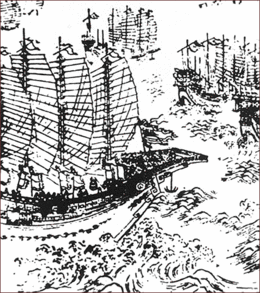| Ming treasure voyages | |||||||||||
|---|---|---|---|---|---|---|---|---|---|---|---|
 | |||||||||||
| Traditional Chinese | 鄭和下西洋 | ||||||||||
| Simplified Chinese | 郑和下西洋 | ||||||||||
| Literal meaning | [Voyages of] Zheng He down the Western Ocean | ||||||||||
| |||||||||||
The Ming treasure voyages were maritime expeditions undertaken by Ming China's treasure fleet between 1405 and 1433. The Yongle Emperor ordered the construction of the fleet in 1403. The grand project resulted in seven far-reaching ocean voyages to the coastal territories and islands of the South China Sea and Indian Ocean. Admiral Zheng He was commissioned to command the fleet for the expeditions. Six of the voyages occurred during the Yongle Emperor's reign (r. 1402–1424) and the seventh voyage occurred during the Xuande Emperor's reign (r. 1425–1435). The first three voyages reached up to Calicut on India's Malabar Coast, while the fourth voyage went as far as Hormuz in the Persian Gulf. In the last three voyages, the fleet traveled up to the Arabian Peninsula and East Africa.
The Chinese expeditionary fleet was heavily militarized and carried great amounts of treasures, which served to project Chinese power and wealth to the known world. They brought back many foreign ambassadors whose kings and rulers were willing to declare themselves tributaries of China. During the course of the voyages, they destroyed Chen Zuyi's pirate fleet at Palembang, captured the Sinhalese Kotte kingdom of King Alakeshvara, and defeated the forces of the Semudera pretender Sekandar in northern Sumatra. The Chinese maritime exploits brought many countries into China's tributary system and sphere of influence through both military and political supremacy, thus incorporating the states into the greater Chinese world order under Ming suzerainty. Moreover, the Chinese restructured and established control over an expansive maritime network in which the region became integrated and its countries became interconnected on an economic and political level.
The Ming treasure voyages were commanded and overseen by the eunuch establishment whose political influence was heavily dependent on imperial favor. Within Ming China's imperial state system, the civil officials were the primary political opponents of the eunuchs and the opposing faction against the expeditions. Near the end of the maritime voyages, the civil government gained the upper hand within the state bureaucracy, while the eunuchs gradually fell out of favor after the death of the Yongle Emperor and lost the authority to conduct these large-scale endeavors. Furthermore, local authorities and elites had economic interests antagonistic to the central state control of commerce, since the state-sponsored maritime enterprise had been key to counterbalancing localized private trade.
Over the course of these maritime voyages, Ming China became the pre-eminent naval power by projecting its sea power further to the south and west. There is still much debate regarding issues such as the actual purpose of the voyages, the size of the ships, the magnitude of the fleet, the routes taken, the nautical charts employed, the countries visited, and the cargo carried.[1]
- ^ Finlay (2008), 330.